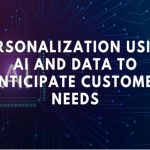 Artificial intelligence is helpful in cyber security because it helps professionals better understand, examine, and evaluate crimes. It advances the tools businesses use to fight cybercrime and aids businesses in protecting client data. Artificial intelligence may be both a blessing and a curse for organizations, customers, and cybercriminals. But what about AI in cyber security? Does your organization’s digital security face a threat or an opportunity from artificial intelligence?
Artificial intelligence is helpful in cyber security because it helps professionals better understand, examine, and evaluate crimes. It advances the tools businesses use to fight cybercrime and aids businesses in protecting client data. Artificial intelligence may be both a blessing and a curse for organizations, customers, and cybercriminals. But what about AI in cyber security? Does your organization’s digital security face a threat or an opportunity from artificial intelligence?
In this post, we’ll learn the value of AI in cybersecurity and how it may improve a company’s online defenses.
Also read: Logistics Goes Intelligent: The Potential of AI in Supply Chain Management
An Overview of the Cybersecurity Industry
Cybersecurity is the defense against cyberattacks on systems connected to the internet, which includes their hardware, software, and data. Individuals and businesses utilize this technique to prevent illegal access to information centers and other digital systems. Moreover, the cybersecurity sector includes a wide range of operational functions for prevention and rectification in almost every medium.
A solid cybersecurity plan can offer a sound security posture against unknown threats intended to gain access to, alter, delete, destroy, or extort sensitive data and systems belonging to a business or user. Implementing security measures is crucial to prevent system or device malfunctions caused by attacks.
The worldwide cybersecurity industry is expanding quickly. Many new technological efforts are driving this market’s rapid expansion. This includes “internet of things” networked devices, stringent data protection laws, and cloud-based workloads and apps that necessitate security outside the traditional data center.
AI’s Role in Cybersecurity and Detecting Cyber Threats

AI is a powerful technology that provides cutting-edge tools to thwart assaults by safeguarding networks and services, identifying and blocking threats, and combating them. It uses autonomous systems and internal restructuring to stop new assaults, in contrast to conventional cybersecurity solutions, which simply identify known threats.
Equally important, AI uses machine learning and deep learning to identify and group patterns on the network. This allows it to detect deviations from the norm or security incidents before reacting. Future security enhances by using these patterns. AI outperforms conventional systems even when just partially implemented, significantly reducing dangers.
Artificial Intelligence vs. Data Analytics
AI systems are repetitive and adaptive. As they process more data, they become more competent, “learn” from their mistakes and grow more capable and independent.
On the other hand, data analytics is a static process that uses specialized systems and software to analyze massive data volumes and make inferences about the information they contain. DA is neither self-learning nor recurrent.
Data analytics identifies patterns based on historical data to forecast future events. In contrast, AI involves data analysis, making assumptions, and attempting to generate predictions that are beyond the capacity of humans.
Using AI for cybersecurity
Humans need help to monitor and evaluate complex networks. AI makes it quicker and more efficient to analyze data from numerous endpoints, allowing for early identification of risks and weaknesses before an assault deploys.
AI is used in cyber security to easily evaluate millions of events and find various dangers, from malware that takes advantage of zero-day flaws to spotting dangerous behavior that could result in a phishing attack or downloading harmful code. This technology is a self-learning system that collects data from all of your company information systems automatically and continually. This data is then analyzed and used to connect patterns spanning millions to billions of indications important to the corporate attack surface to discover new types of attacks.
Deep learning and unsupervised learning have enormous benefits for cybersecurity. They can examine and mitigate sizable sets of potentially harmful data without requiring human engagement while also making recommendations for potential future risks.
AI for Cyber Safety has several uses and advantages. It uses the capacity to spot unusual patterns and weaknesses inside extensive networks. In addition, it includes Better threat intelligence along with accurate risk ratings. Moreover, it also can automate processes.
Also check out: The Rise of Intelligent Automation: The Future of Work with AI
How Can Artificial Intelligence Testing Enhance Cybersecurity?
Detecting New Threats
The company’s internal network and any utilized cloud services are analyzed and learned as part of the AI-based cyber threat detection process. Instead of using pre-programmed patterns, it records each person’s unique behavior. The AI continually tests this behavior, and Clue Security analysts validate it. In real-time, AI uses behavioral analysis to spot harmful activity and provides prompt defenses against attacks.
Battling Bots
Botnets can perform malicious actions to disrupt and take down websites. Malware-based bots can also steal data and personal information, and this practice is on the rise.
Agencies need technologies that can evaluate bot behavior to assist them in differentiating between benign and harmful traffic instead of just barring or allowing bots. Security personnel frequently try to decide what to search for, making bot identification difficult. But, analysts can use a machine learning algorithm to determine the most crucial data to search for in the data if they can gather a large set of event data with plenty of details.
Breach Risk Prediction
The IT asset inventory, a precise and thorough list of all devices, users, and apps with various levels of access to multiple systems, is determined using AI algorithms.
With AI-based systems, predicting potential attack areas and vulnerability becomes possible, enabling the allocation of resources and tools. You may create and optimize policies and processes to increase your organization’s cyber resilience using prescriptive insights from AI analysis.
A false positive happens when a security system labels safe software as dangerous or detects a threat that doesn’t exist. Although there are many potential causes, an overly sensitive system or a bug in the instrument or remedy are the main culprits. AI can easily take care of this.
Better Endpoint Protection
People are heavily dependent on laptops, smartphones, and other gadgets. These endpoints are a prominent target for cybercriminals because they are easily lost or stolen, making them the weakest link in the security chain. Artificial intelligence scans and monitors endpoints for malicious activity and finds vulnerabilities that threat actors can exploit.
VPNs and antivirus programs can protect users from ransomware and other remote malware threats but frequently operate based on signatures. This implies that staying current with signature definitions becomes essential to remain safe against the most recent threats.
There are several protections that next-generation endpoint protection software utilizing artificial intelligence and machine learning can provide that conventional endpoint protection cannot. They identify suspicious activity by unauthorized users, applications, or network services and prevent it from happening. A ground-breaking AI-based endpoint protection solution brings artificial intelligence to every endpoint, detecting assaults in their earliest stages in real time.
Specific Applications of AI in Cybersecurity
Let’s look at some of the most specialized uses of AI in cybersecurity now that we understand what it includes.
1. Identification of malware
Using AI technology will allow for processing malware datasets and analyzing malware to comprehend its features in malware detection systems.
2. Breach risk analysis
AI-based systems can determine how and where you are most likely to be compromised so that resources can be allocated and directed toward areas with the most significant risks.
Using prescriptive insights from AI-based analysis, you may set up and enhance policies and procedures to boost your cyber resilience.
3. Spam filtering and bot detection
Using AI and machine learning, it is possible to differentiate between good and malicious bots and people to gain a complete understanding of website traffic. We can evaluate enormous amounts of data thanks to AI, and cybersecurity teams may modify their tactics to take advantage of the constantly changing environment.
4. Measures to prevent phishing
Artificial intelligence, which analyzes data to look at normal user behavior, is the finest tool for spotting and combating phishing. Devices with AI capabilities have the size and intelligence to handle future increases in phishing activity. They can use their knowledge of email context, content, metadata, and trusted behavior to analyze hundreds of thousands of emails for abnormalities like phishing efforts.
5. Password security and user identification
AI tools can assess the strength of passwords by combining their program with current password-cracking tools. While some people may find this discovery unsettling, scientists think that this technology may be able to outwit hackers at their own game.
You may also like: AI in Human Resource Management: Enhancing the Recruitment Process
Downsides of AI in Cybersecurity
Using AI for cybersecurity has some disadvantages. Organizations would require a significant increase in resources and capital expenditures to develop and sustain an AI system. Since AI systems train using data sets, you must compile various collections of malware codes, benign codes, and abnormalities. It is necessary to gather these data sets, which takes time and costs money that most businesses need help to afford.
Also, the collection and processing of vast amounts of data by AI systems employed for security can cause privacy concerns. This data may contain personal information that, if improperly protected, could lead to identity theft, financial crime, or data breaches.
Future of AI in Cybersecurity
In the coming years, cyber-attacks will hasten by leveraging cutting-edge tools like automation, machine learning, and artificial intelligence. To defend against the attacks, companies will need to adapt and use the same AI techniques. AI will keep assisting businesses in protecting their networks and systems as they incorporate new technologies.
Some early AI adopters
Several early adopters of AI have reaped significant benefits and anticipate continuing to do so. Let’s examine the first early adopters and the AI they have applied.
Google: Since its debut 18 years ago, Google’s Gmail has used machine learning algorithms to filter emails. Highly educated and employed in almost all of its services, machine learning enables algorithms to practice self-regulation and make more autonomous adjustments.
Juniper Networks: The networking community is starving for innovative solutions to the networks’ unsustainable economics. A production-ready, financially viable Self-Driving NetworkTM is how Juniper sees the answer to this issue developing.
IBM/Watson: Regarding “knowledge consolidation” jobs and machine learning-based threat detection, the IBM team increasingly relies on its Watson cognitive learning platform.
FAQs
How will artificial intelligence change cyber security?
The fundamental principles of AI-enabled systems are gathering data, analyzing it, deciding while knowing the consequences, and learning from the outcomes. Because of this, using AI for cybersecurity creates new opportunities for defense and difficulties for an offense.
Attacks are becoming more frequent, prompting AI adoption in cybersecurity to provide effective and precise data defenses. Building intelligent threats and guards is made simpler by AI.
The field of cybersecurity requires a lot of knowledge and is constantly evolving. Every day, threat models change, attackers’ motives shift, and IT systems are continually being deployed and getting older. With the aid of an AI cybersecurity assistant that can process all of these details, a security analyst can have options and suggestions to consider, which rates with high degrees of confidence.
Can AI improve cybersecurity?
Every modern firm uses information technology. Nevertheless, maintaining the security of your IT cannot be easy. Thankfully, AI makes a more straightforward approach possible. Developers are utilizing AI to strengthen biometric authentication and eliminate weaknesses, increasing its sturdiness. To detect and stop cyber threats, AI is to “lend a hand” and support humanitarian efforts. AI-powered data storage solutions will be one of the best methods to lessen dangers.
Defenders can more quickly identify attacks by using artificial intelligence to detect them rather than manually examining networks.
“AI to replace humans in cybersecurity.”
AI might replace cybersecurity employment, but cybersecurity professionals won’t vanish. The new cybersecurity skill set will only replace the current skill set. AI will never replace human abilities like leadership, empathy, and strategic thinking.





